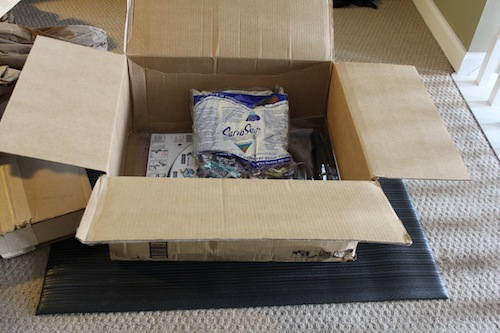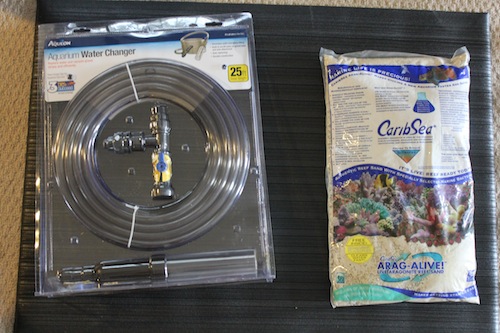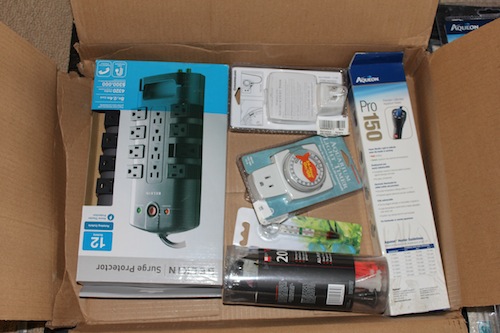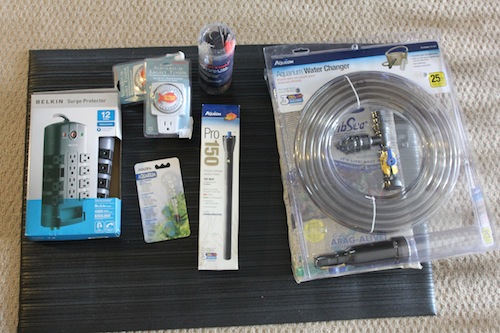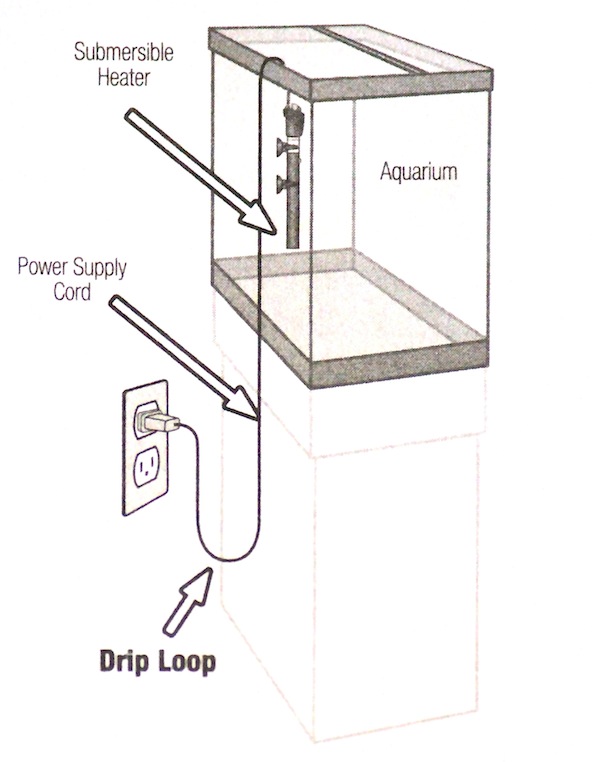At Aquarium Tip Tank we love our pet fish and we enjoy setting up and taking care of our tropical fish tanks. We love them because they’re beautiful, they are tools for education about underwater ecosystems, they are tools to promote marine conservation, they are fantastic and proven stress relievers, and they are just plain fun! For more on that, listen to Aquarium Tip Tank’s First Podcast!
However, before you jump into this wonderful hobby, there are a few things to consider if you’ve never taken care of a home aquarium before. We definitely don’t want to scare you off, but please realize that the fish in your tank will be your pets. Just like any other pet there is some research that you should do prior to picking out your pet, and there are some pieces of equipment that you will need in order to bring home your new pet and keep it healthy and happy.
Before you buy a Tropical Fish Tank:
For a home aquarium, the initial stages of research, equipment purchase, and tank setup, before you actually purchase and bring home any fish, accounts for the biggest chunk of time that you will have to devote to your new hobby. The size of your aquarium tank and the type of livestock you choose to keep will determine how simple or complex the maintenance of your tank will be.
Tank Selection and Fish Research:
In the end, the environment that you create in your tank must match the healthy living environment of the livestock that you want to keep. The task is to simulate the natural environment of the fish that you choose to keep as closely as possible. So, one of the first steps is to do some research into the kind of livestock you want to keep. You may want to keep an Emperor Angelfish (Pomacanthus imperator), but when you start doing your research you figure out that a minimum tank size of 220 gallons is recommended to keep an Emperor Angelfish.
Our thought is that you have to start with tank selection and livestock research simultaneously. Do you have such an undying need to keep an Emperor Angelfish that you will use whatever spot in your home is big enough for a 220 gallon tank? Or, do you have the perfect spot for a tank in your home, but you can only fit a 50 gallon tank there? If you can only fit a 50 gallon tank, then you will have to do some research and find some tropical fish to keep that will do well in the environment that you can create with that 50 gallon aquarium.
Personally, I like to find the spots in my house with esthetic quality first, figure out the maximum tank size that I can put in that space, and choose my fish based on that tank size. I like to find a spot in my house where myself and my guests will see the tank, ask questions about the fish, invertebrates, and other livestock, and where its easy to relax and enjoy the personalities of my pet fish. But that’s just me. Maybe you want that Emperor Angelfish so much that you will put a large tank in your large, unfinished basement where most people don’t regularly go. It is up to you. If you need some help selecting a tank, go ahead and sign up for our FREE Tank Selection Worksheet and our e-updates and newsletter.
You’ve selected a tank location, and a tank size. You’ve purchased the tank you’re going to use and researched and selected some fish that you are able to keep in that size tank. What’s next?
Aquarium Equipment Selection:
While doing the research on the fish that you want to keep you may have realized that there are certain environments that your livestock normally lives in. The water temperature must be kept steady, the tank has to be lit to mimic the sunlight that the inhabitants of your tank normally receive, and the water quality needs to remain pristine with the use of a filtration system.
There are several varieties and countless brands of every piece of aquarium equipment. You can do hours upon hours of research to figure out exactly which pieces of equipment you want to purchase, or you can walk in to your Local Fish Store (LFS) and purchase whatever the salesperson suggests for you. The problem with walking into your LFS and immediately walking out with an aquarium setup is that you end up with less of an understanding of how everything works together to create the underwater ecosystem that you want to keep. You won’t know why you were sold those specific pieces of equipment. Maybe it was the best for your intended aquarium, or maybe it was the pieces of equipment that cost the most. We suggest that you at least do some research into the types of equipment that you want to use.
Fish Tank Setup
Now that you’ve purchased your tank, tank stand, filtration equipment, heater, thermometer, lighting, light timers, surge protectors, water additives, substrate, rocks, and decorations its finally time to actually setup your tank so that you can put fish in it! First, you need to place everything and attach it correctly on, in, and around your aquarium. Anything that is going into the tank and is going to be submerged in the aquarium water MUST FIRST BE RINSED off before placing it in the desired location in the tank. This includes your gravel, aquarium safe decorations, rockwork, etc.
Finally, its time to put water into the tank. If you are starting a saltwater aquarium, you may have to make the saltwater first. Once the water is in your tank YOU MUST CYCLE YOUR TANK. A whole article can (and will) be written about the Nitrogen Cycle and how to go about cycling your tank, but for now, just realize that it could take anywhere from 1 week to 6 weeks.
Now that everything is set up and properly cycled, fish can be added to the tank. From this point on, fish tanks require relatively little maintenance. There are many aquarium hobbyists that may laugh at that statement and completely disagree. However, we must remember that our fish are our pets. As with any pet, they need to be fed, and there are health and maintenance tasks that must be performed on a regular basis to keep our pets happy and healthy.
We have to feed our fish every day, just like any other pet, so we should also do a few quick water quality checks every day. While we’re feeding our fish, it only takes a few seconds to check the water temperature, make sure all of our pumps, lights, heaters, and timers are still in working order, and it will be obvious if some algae and grime needs to be cleaned off the inside walls of the tank. This usually takes less than 5 minutes a day. This is less time than it takes to walk, play with, feed, and take care of almost any other pet every day.
There are also bigger maintenance tasks that must be performed on a regular basis, but they are not daily tasks. It is recommended that a 20%-30% water change is performed on a weekly to bi-weekly basis. It is imperative that filter media be changed about once every 2 months. In conjunction with these, water quality testing should also be performed. The time it takes to perform these tasks depends on the size of your tank, how easy it is to change your filter media, and the demands of the livestock.
The Price of a Home Aquarium
All of these pieces of equipment that we’ve talked about so far need to be obtained for use somehow. Again, the cost of these items will depend on the size of your tank and the demands of the livestock you choose to keep. For example, a freshwater, fish only aquarium with fake, aquarium safe decorations, does not demand the specialized lighting and filtration systems that a planted tank or a saltwater reef tank does.
You also may be able to find hand-me-down equipment, equipment on Craigslist, or on aquarium websites with deals like That Fish Place. Personally, I’m in the process of starting a saltwater tank that I got from my brother-in-law. He used to use the tank and tank stand for a freshwater aquarium. With everything that you might get as a hand-me-down or from Craigslist, just make sure that everything works, nothing leaks, and you clean everything out.
Of course, the fish and other livestock for an aquarium also cost money. You also need to make sure you have food, and there are a few very low cost tools ($10 or less each) that you will use when performing routine maintenance. Once again, this is not unlike any other pet.
In conclusion, a decision should be made about if you want to do all of the necessary research, if you have the time, and if you have the money to take care of a pet. Every pet requires some initial research, some time to take care of them, and some equipment to make sure that they are in a happy, healthy, and clean environment. If it is tropical fish that you want to keep, then join us at Aquarium Tip Tank, and ask us any questions you may have about home aquariums and the beautiful underwater ecosystems.
TJ


